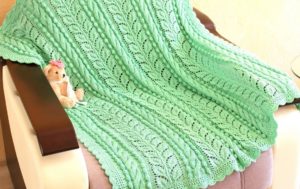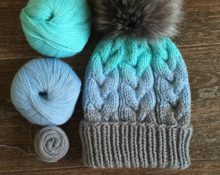 As a mother, any woman strives to take the best possible care of her child. Its comfort comes first. Therefore, it is especially pleasant to make beautiful and comfortable things for your baby with your own hands, for example, a knitted blanket. It can be made by knitting or crocheting. Even if you are new to knitting, you can do this job.
As a mother, any woman strives to take the best possible care of her child. Its comfort comes first. Therefore, it is especially pleasant to make beautiful and comfortable things for your baby with your own hands, for example, a knitted blanket. It can be made by knitting or crocheting. Even if you are new to knitting, you can do this job.
Calculation of yarn consumption
Before starting knitting, any needlewoman must find out how much material she will need to create the product. This action takes into account the following characteristics:
- Thickness and twist of the thread;
- Dimensions of the future product;
- Tool for creating a canvas;
- Patterns used.
Advice! If you are not confident in your ability to correctly perform the calculations, select a model with a detailed description of the work and indicating everything necessary.
What determines the amount of yarn for a blanket?
When determining the amount of yarn, the following characteristics are taken into account:
- Thickness and twist of the thread;
- Dimensions of the future product;
- Tool for creating a canvas;
- Patterns used.
Advice! If you are not confident in your ability to correctly perform the calculations, select a model with a detailed description of the work and indicating everything necessary.
The influence of a specific blanket model on yarn consumption
The quantity will be affected by the model you choose. Namely, its following parameters.
- Canvas dimensions. Larger size will require more material consumption.
- How the product is made: a single canvas or individual motifs. The second option will be more expensive.
- Crochet or knitting needles. The hook fabric will “eat” more material.
- Arana, openwork or satin stitch. Openwork knitting is the least expensive; a little more yarn will be spent on simple knitting. And the largest amount will be needed for arans.
Reference! Sometimes craftswomen make a blanket from two layers. Openwork lace on top and satin stitch on the inside. In this variation, the calculation for each layer is performed separately.
- Thickness of yarn. For complex weaves, it is better not to use coarse, thick yarn. Otherwise, the product will turn out unpleasant to the touch.
How to calculate yarn consumption yourself
To calculate the flow rate, you will need to knit a sample of the pattern you are using. Then follow the diagram.
- Calculate the area of the blanket.
- Calculate the area of the sample.
- Unravel the sample and measure the length of the thread. You can also simply measure the mass of the sample.
- Multiply the area of the blanket by the length of the thread or the weight of the sample.
- Divide the result by the area of the sample.
You will get the meter of thread or the mass of the entire material.
Attention! Before measuring the sample, it is required to carry out wet-thermal treatment.
Examples of yarn consumption for children's blankets
Now let's look at various examples of the amount of material needed. For knitting needles and crochet hooks these will be different values.
Knitting needles
A combination of different weaves: openwork and aran looks good in such a product.
Openwork and arans

The dimensions of this blanket are 1x1.2 meters. To implement this you will need yarn with a composition of 60% cotton/40% acrylic with parameters of 150 m/50 g.
In total, you will need approximately 10–11 skeins, i.e. about 1700 meters.
Shadow stitch
In the next variation, the pattern is formed by alternating knit and purl stitches.

- Dimensions: 122x153 cm.
- Material: yarn 55% cotton/45% polyacrylic 300 m/100 g.
- Flow: 1000 m.
From individual motives
The next option is obtained by knitting individual elements that are assembled into a single fabric.

- Size: 110x110 cm.
- Material: 100% cotton with parameters 400 m/100 g.
- 1800 m will be required.
Crochet
Crocheted fabric requires more material to create than a knitted product of the same size. But it looks more delicate and light.
Simple option

- Size: 95x95 cm.
- Material: 55% cotton/45% polyacrylic 320 m/100 g.
- How much material is needed: 300 g.
Motives

- Size: 88x88 cm.
- Material: Pekhorka “Children’s novelty” 100% acrylic 200 m/50 g.
- Consumption: 350 g.
All data can be considered as rough guidelines.


 0
0





